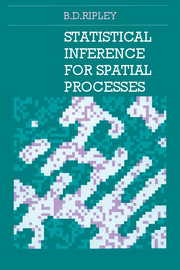1 - Introduction
Published online by Cambridge University Press: 05 June 2012
Summary
This essay aims to bring out some of the distinctive features and special problems of statistical inference on spatial processes. Realistic spatial stochastic processes are so far removed from the classical domain of statistical theory (sequences of independent, identically distributed observations) that they can provide a rather severe test of classical methods. Although much of the literature has been very negative about the problem, a few methods have emerged in this field which have spread to many other complex statistical problems. There is a sense in which spatial problems are currently the test bed for ideas in inference on complex stochastic systems.
Our definition of ‘spatial process’ is wide. It certainly includes all the areas of the author's monograph (Ripley, 1981), as well as more recent problems in image processing and analysis. Digital images are recorded as a set of observations (black/white, greylevel, colour…) on a square or hexagonal lattice. As such, they differ only in scale from other spatial phenomena which are sampled on a regular grid. Now the difference in scale is important, but it has become clear that it is fruitful to regard imaging problems from the viewpoint of spatial statistics, and this has been done quite extensively within the last five years.
Much of our consideration depends only on geometrical aspects of spatial patterns and processes.
Information
- Type
- Chapter
- Information
- Statistical Inference for Spatial Processes , pp. 1 - 8Publisher: Cambridge University PressPrint publication year: 1988
